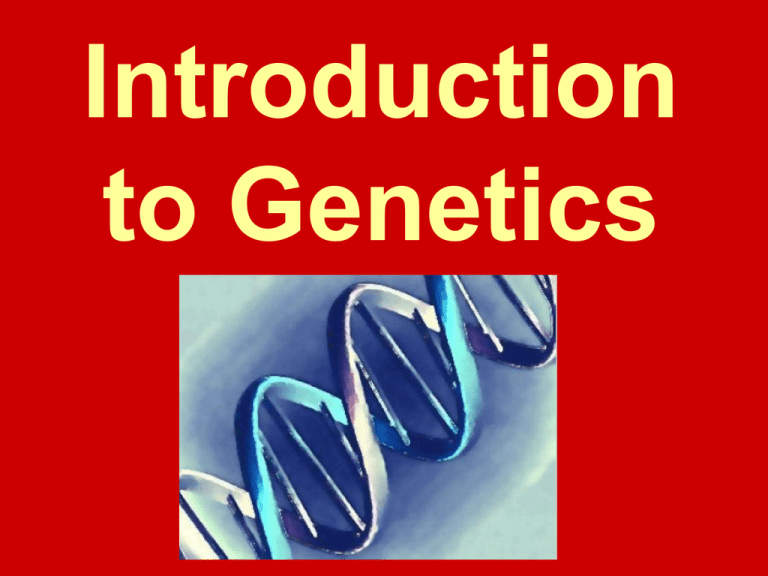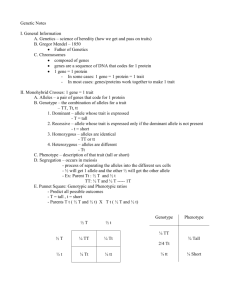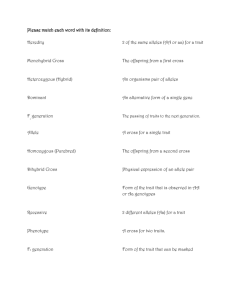Introduction to Genetics
advertisement

Introduction to Genetics Heredity • The passing on of characteristics from parents to offspring Traits • Characteristics that are inherited Genetics • The study of heredity –Genes: chemical factors that determine traits • Can occur in 2 different forms called alleles Gregor Mendel • Father of genetics • 1st to succeed in predicting how traits would be transferred from one generation to the next • Used pea plants • Pea plants reproduce sexually – Produce male and female sex cells (gametes) – Fertilization: male and female gametes unite, resulting in a zygote (fertilized egg) • Controlled plant crosses by removing male parts • Mendel studied only 1 trait at a time (7 total traits) – True-breeding pea plants: • Produced identical offspring • Ex: tall or short, green or yellow • Crossed a tall plant with a short plant – Parent generation (P1) – Offspring called hybrids (F1) • Have different forms of a trait • Showed characteristics of only 1 parent – Observed traits are dominant – Traits that seem to disappear are recessive – Allele for tall plants is dominant to the allele for short plants – Inherit one gene from mom and one from dad • Organisms can look alike but have different combinations of alleles • Different forms of a gene for each variation of an inherited trait • Phenotype: way an organism looks and behaves – Physical characteristics – Ex: height (tall, short), skin color (red, white, blue..etc), head size, eye color…etc • Genotype: Allele combination an organism contains – Genetic make-up – Assigned a letter to represent the trait – Ex: TT, Tt, tt • Homozygous: 2 alleles for the trait are the same – Called true-breeding – Ex: TT, CC, HH, tt, cc, hh • Heterozygous: 2 alleles for the trait differ from each other – Called hybrids – Ex: Tt, Cc, Hh, Ss Punnett Squares • Way to find expected proportions or probability of possible genotypes in the offspring of a cross • Probability – Likelihood an event will occur – Used to predict outcomes of a genetic cross – Way alleles separate is random – Cannot give actual outcome • Monohybrid cross (mono-: means one) – Focus on 1 trait – Ex: height T= tall, t= short texture S= smooth vs. s= rough, – Crossed a tall plant with a short plant Mendel’s Crosses • 1st generation plants (F1) were all tall –Self-pollinated to make 2nd generation plants (F2) • 2nd generation plants: –¾ were all tall plants –¼ were short plants • ex: First generation plants (F1): all tall ex: Second generation plants (F2) Punnett squares are good for showing all the possible combinations of alleles and the probability of inheriting a trait Bell Ringer: 1. Which 2 combinations of alleles could produce a trait controlled by a dominant allele? 2. What combination of alleles could produce a trait controlled by a recessive allele? 3. If a heterozygous plant for seed color (Rr) is crossed with a homozygous recessive plant (rr), what is the probability of each seed color being produced? Draw a punnett square to show work. 4. Organisms that have identical alleles for a particular trait are: a. heterozygous c. diploid b. polygenic d. homozygous Dihybrid Crosses (di-: means 2) • Involve two traits • Mendel: used seed color and seed texture – Crossed round yellow seeds (RR and YY) with wrinkled green seeds (rr and yy) – Round is dominant to wrinkled – Yellow is dominant to green • 1st generation (F1) plants: round and yellow (RrYy) • 2nd generation (F2) plants: – – – – round yellow (9) round green (3) wrinkled yellow (3) wrinkled green (1) Rule of Dominance • • • • Some alleles are dominant and others are recessive Pea plants with 2 alleles for tallness were tall Pea plants with 2 alleles for shortness were short Dominant allele: observed trait – Upper-case letters = Dominant allele (always put capital letter 1st for the genotype) – Ex: allele for tallness (T) • Tall Plants: TT or Tt • Recessive allele – Lower-case letters = Recessive allele – Always listed after the dominant allele – Will only appear if no dominant allele is present – Ex: allele for shortness (t) • tt short plant – Disappears Law of Segregation • Every individual has 2 alleles of each gene • When gametes are produced, each gamete receives 1 of these alleles – Randomly pair to produce 4 combinations of alleles during fertilization Tall plant: Short plant: TT x Yellow plant x YY x tt = Tt Green plant: yy = Yy F1 generation Tt Tt T TT Tt X t Tt gametes T Tt F2 generation t tt Law of Independent Assortment • Ex: Does a gene that determines whether a seed is round or wrinkled have anything to do with seed color? • Genes do not have to be carried together – Travel independently • Genes for different traits can segregate independently during formation of gametes – Accounts for the wide variety of genetic combinations in offspring • Genes for different traits are inherited independently of each other Incomplete Dominance • “blend” or mixing of traits • neither allele is completely dominant • phenotype of heterozygous individuals is intermediate (in the middle) • mix of purebred phenotypes • ex: Red flowers (RR) x White flowers (R´R´) = Pink flowers (RR´) Codominance • phenotypes of both homozygotes are produced – both are dominant • both alleles contribute to the phenotype but do not blend together – both alleles are expressed equally • ex: chickens – Black chickens (BB) x White chickens (WW) = checkered or speckled chickens (BW) • ex: red cow (RR) x white cow (WW) = roan cow (pinkish brown RW) • ex: Sickle-Cell anemia Multiple Alleles • Genes with more than 2 alleles • Ex: rabbit coat color, blood type, eye color Polygenic Inheritance • inheritance pattern of a trait that is controlled by 2 or more genes • may be on the same or different chromosome • each gene can have 2 or more alleles • ex: skin color, fruit fly eye color Bell Ringer: 1. According to the principle known as _______, genes that segregate independently do not influence each other’s inheritance. 2. The separation of alleles during gamete formation is called ____. a. segregation b. true-breeding c. meiosis d. crossing-over 3. Which of the following structures assort independently? a. genes b. crossovers c. chromosomes 4. Genes on the same chromosome a. never separate c. always separate b. sometimes separate d. don’t show linkage d. genotypes Applying Mendel’s Principles • Thomas Hunt Morgan (1900’s) – Studied fruit flies – Observed fruit flies produce a lot of offspring quickly • Mendel’s principles apply to all living organisms Linkage and Gene Maps • Each chromosome is a group of linked genes • Chromosomes assort independently (not individual genes) • Genes can separate by crossing-over – Gives genetic diversity – More likely to be separated the further apart they are on the chromosome • Gene map – Shows locations of known genes on a chromosome Simple Dominant Heredity • Only need to inherit 1 dominant allele to display the trait • Tongue rolling • Free earlobes • Hitchhiker’s thumb • Dimples • Cleft chin • Freckles Bell Ringer: 1. Which of the following shows the relative locations of each known gene in an organism? a. polygenic trait b. punnett square c. gamete d. gene map 2. Match the type of inheritance with its correct description: incomplete dominance multiple alleles codominance polygenic traits _______ both alleles contribute to the phenotype of the organism _______ more than two possible alleles for a trait exist in a population _______ traits controlled by two or more genes _______ one allele is not completely dominant over the other allele






